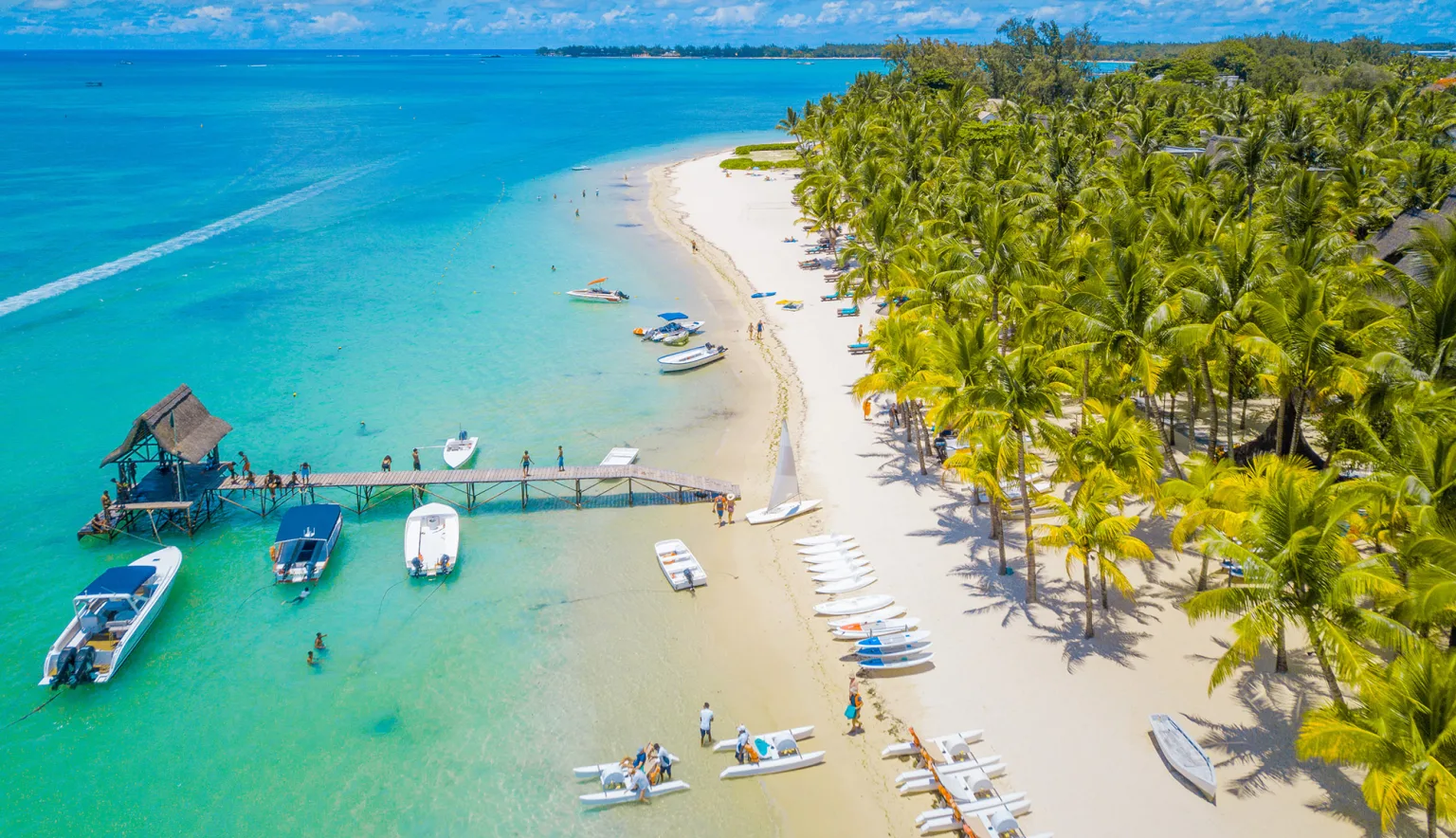The pear-shaped ‘pearl of the ocean’, Mauritius is an isle of sensory stimulation and a burgeoning green destination.
MAURITIUS
Floating 1,200 miles off the coast of Madagascar lies the island of the Republic of Mauritius. Surrounded by cerulean waters and fringed with beaches coated in icing-sugar sand, this compact landmass of just 45 by 65 kilometres is an explosion of colour.
The island’s verdant interior hosts a kaleidoscopic array of birdlife, from parakeets to Mascarene paradise flycatchers, while its social fabric resembles a vibrant tapestry woven with threads of cultures from all around the world. This enriching diversity is best experienced through Mauritius’ renowned gastronomy, which represents a culinary mosaic of Indian, African, Chinese, Muslim and European heritage. A fertile patch of Eden, Mauritius supports a thriving farm-to-table culinary scene best sampled through its restaurants and street vendors.
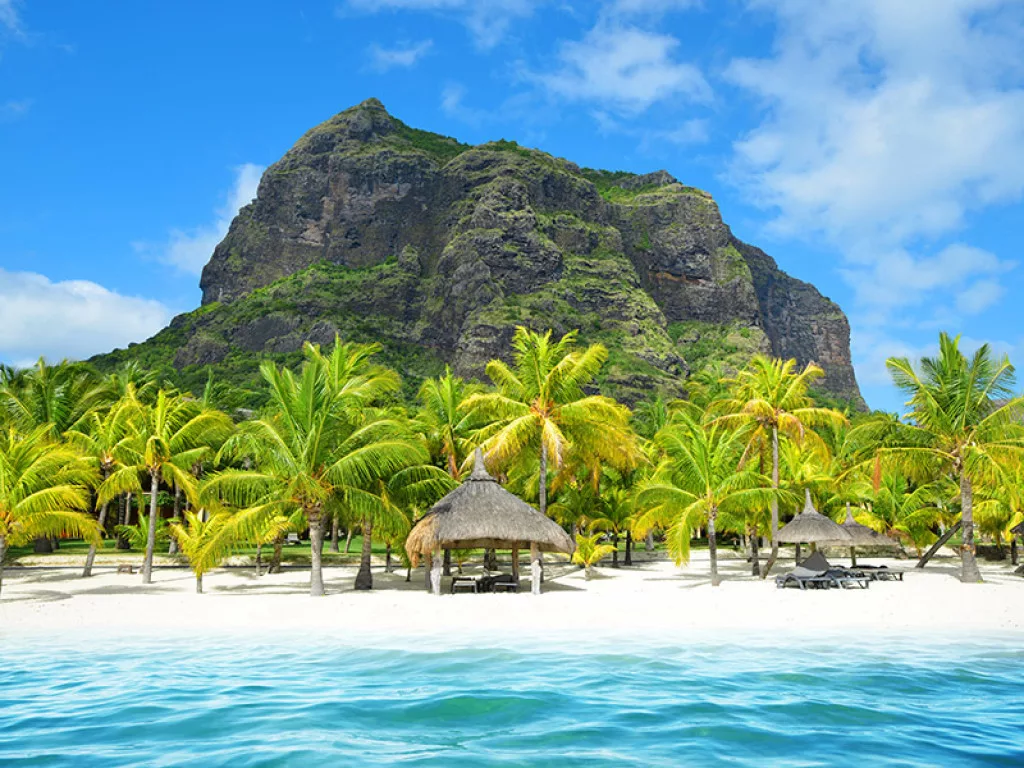
Blessed with the year-round sun of the sub-tropics, Mauritius has long been a haven for luxury resorts, however, look beyond the beaches and a cornucopia of delights lies in wait, including charming fishing villages, thriving local markets and tranquil tea estates.
Outdoor enthusiasts can hike amongst the three main mountain ranges surrounding the central plateau – Moka, Black River Chain and Grand Port – which host hiking trails ripe for adventure, while the multi-coloured sand dunes of the Chamarel Seven Colored Earth Geopark are a natural wonder. Meanwhile, Mauritius’ submarine depths boast world-class diving and snorkelling sites, while above the surface, paddleboarding and exhilarating kitesurfing off the southwestern peninsula at Le Morne await.
The national emblem of Mauritius may be the long-extinct dodo, but the magnetic appeal of the pearl of the Indian Ocean continues to resound as strongly as ever. As the American author Mark Twain famously put it, “Mauritius was made first, and then heaven; and heaven was copied after Mauritius.” Take our word for it, he may have a point.
TOURISM INSIGHTS: TOURISM AUTHORITY
Operating under the aegis of the Ministry of Tourism, the Tourism Authority is the parastatal body overseeing Mauritius’ thriving tourism industry. We interview the Authority’s Director, Lindsay Morvan, to delve further into the island’s sustainability efforts.
Q&A WITH LINDSAY MORVAN, DIRECTOR, TOURISM AUTHORITY
What are the Tourism Authority’s key goals as an organisation?
Lindsay Morvan, Director (LM): Among the many objectives of the Authority, the promotion of sustainable development of the tourism industry and a green destination status for Mauritius are among our upmost priorities.
We foster and encourage the conduct of activities in the tourism industry in a responsible manner to preserve the integrity of the destination while preserving its environmental, cultural and social assets. This is done through enhanced coordination and cooperation between the public sector agencies and the private sector organisations involved in the tourism industry. Our functions are multi-fold, focusing on licensing, regulating, and monitoring of the tourist enterprises. As such, all operators who wish to engage in tourism activities need to be a full-fledged licensee from the Tourism Authority.
In addition, the Authority is also responsible for the cleaning and embellishment of official tourist sites of our main island. In line with the scope of the Tourism Authority, the Sustainable Island Mauritius (SIM) was born; a project co-financed by the European Union under the SWITCH Africa Grant since 2018. The main goal of this initiative is to promote sustainable tourism in Mauritius by demonstrating and scaling up a self-sustaining mechanism for improving sustainability impacts along the value chain. It also targets the improvement of awareness and markets sustainable tourism products and services to new visitors.
What kind of travellers does Mauritius appeal to most?
LM: Mauritius has always received visitors from around the world. Our island is blessed with wonderful weather almost all year round, and its offering is not limited to beautiful beaches and breath-taking seascapes; it’s packed with beautiful culture, history, exotic cuisines, astonishing biodiversity, and a lush environment.
The mix of visitors is wide ranging, from honeymooners, family travels, business, cultural, MICE, sports tourism and others. Europe remains our main source market while regional markets such as South Africa and Reunion Island are also very important to us.
With a broad perspective of our community, most visitors coming to the island are those who seek excellent service hospitality, enjoy coastal and outdoor recreational experiences like hiking and water activities, are looking for places to get to know about our local history and culture, and to experience the multicultural faceted nature of the island through the local cuisine, and cultural and religious festivals and events. It is also for those looking to see and explore our pristine beaches and other unique places.
Are there any new tourism initiatives or schemes on the island that you would like to highlight?
LM: Through SIM, our goal is to make Mauritius a certified green destination in the years to come. To achieve this, over 3,500 operators, including taxi drivers, tour operators, hoteliers, tour guides, artisans, local entrepreneurs, boat, and pleasure craft operators from Mauritius and our sister island Rodrigues have benefited from capacity building, coaching sessions, and co-creation ateliers to ensure a better understanding of sustainability, safety and protection of the environment and marine biodiversity, and extend business opportunities for all operators involved.
To engage the population as a whole and reach operators in the industry, a series of workshops, networking events, sensitisation and beach clean-up campaigns have also been organised. Moreover, in May 2022, we launched the first edition of the Sustainable Tourism Mauritius Awards 2022 (STMA), where the winners were rewarded for keeping sight of their aspirational, actionable sustainability goals in their offerings and operations while also being instrumental in COVID-19 crisis recovery. We’ve received over 115 applications across various categories including Hotel & Accommodation, Tour Operator & Tour Guide, Boat & Pleasure Craft Operator, Handicraft & Local Product, and Other Business for this event.
As a result of collective brainstorming facilitated by our external experts CSCP (Collaborating Centre for Sustainable Consumption and Production), SIM produced a policy recommendation report for a more sustainable and inclusive tourism, entitled ‘Low Carbon and Resilient Mauritius’, focusing on three policy factsheets under the following themes:
- Transitioning towards electric in-lagoon boats
- Sustainable Golf Management
- Nature-based solutions in Mauritius
In May 2022, SIM held a multisectoral policy dialogue with tourism specialists, giving them the opportunity to share their views, discuss the cross-sectoral implication on the proposed sustainable actions and join forces in generating ideas and innovations to the report.
The conclusions and recommendations adopted at the meeting are intended to assist government, employers, and workers to harness the full potential of the tourism sector to support a sustainable and resilient recovery and transition to a more inclusive, sustainable, and resilient future of work in tourism.
Moreover, SIM, together with the Mauritius Standard Bureau (MSB), launched the local eco-label certification, MS165 Blue Oasis, which is also recognised by the Global Sustainable Tourism Council (GSTC). MS165 was developed to guide the sustainable development of the tourism industry in Mauritius. It is meant for any tourism business or any tourism-related activity to enhance its sustainability performance. We believe that through this local certification, stakeholders will take the best of advantages to level up their operations to meet best sustainability practices. To date, Mautourco, one of the largest Destination Management Companies (DMC) on the island, and Constance Belle Mare Plage, are the first tour operator and hotel respectively to obtain the certification.
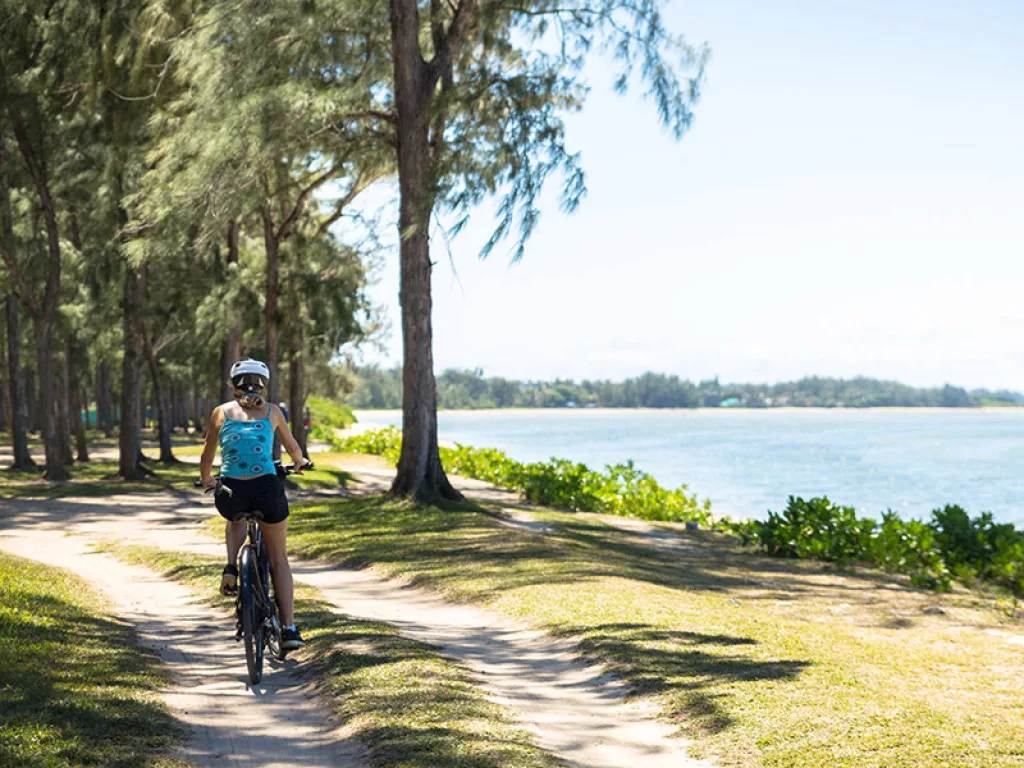
How does Mauritius cater to travellers looking for sustainable or eco-friendly travel experiences?
LM: Discerning travellers and corporate bookers are more and more looking for destinations, attractions, accommodations, and activities that can prove a level of eco-awareness and sustainability in their operations. We believe that by having an internationally recognised green sustainable standard or certification, tourism operators can show to the world that their businesses take environmental considerations seriously and are taking practical steps to tackle issues such as energy efficiency, water saving and mindful waste reduction. Given the vast and complex nature of all the associated tourism value chain, one of our first initiatives is to encourage the certification of the accommodation sector, encompassing large hotels to the smallest of tourist residences.
Through the Tourism Authority, the Ministry of Tourism in Mauritius recently became one of the first destination partners to join the WTTC Hotel Sustainability Basics. The programme focuses on fundamental sustainability criteria, developed by the industry for the industry, and is the minimum that all accommodation providers should meet, helping to raise the floor of sustainability in our sector and country. This will be the initial step for the accommodation sector to embark on this sustainable journey, and subsequently inspire to go through a certification afterwards.
Furthermore, we are developing the digital app for Mauritius Pro-handprint Innovation (MauPHI) toolkit; a tool developed to fit the purposes and needs of local tourism actors, supporting them to visualise sustainability trends and anticipate future risks and opportunities. The latter is expected to be launched by mid-2023. The app will be used by all operators in the industry who are willing to implement sustainable actions in their day-to-day operations and also share with all francophone destinations through L’Organisation Internationale de la Francophonie.
In terms of marketing initiatives, SIM together with the Mauritius Tourism Promotion Authority (MTPA), developed two sustainable tourism videos: one with a focus on new emerging nature-based activities, and a second one on local gastronomy in both Mauritius and sister island, Rodrigues. These videos were broadcasted at international tourism travel fairs like WTM London, Top Resa Paris and TTG Travel Experience Rimini.
Is it important for Mauritius to offer socially responsible tourism experiences that benefit the local community?
LM: Definitely. As the main beneficiary of the SIM project, the local DMC Mautourco, was selected as the pilot company to develop the MauPHI. An in-depth self-diagnosis of the DMC’s activities was conducted to design a mission and vision statement towards sustainable best practices in all sectors of operations through capacity building of their employees. Thereafter, a sustainable package including the whole value chain in collaboration with Der Touristik and Beachcomber Hotels as partners was developed. The ‘Wise Dodo’ package was introduced on sales in Germany by Dertour. You can view the video here.
Further to this, we believe that local SMEs, NGOs, associations, communities, and visitors themselves should take an active role towards sustainable, regenerative tourism and circular tourism products. In 2021 and 2022, SIM joined forces with Made in Moris, a Mauritian label for high quality, locally made products that have years of experience working with over 350 Mauritian brands in the handicraft sector and other fields, to deliver online webinar sessions over five weeks to around 15 local artisans or entrepreneurs to assist them in developing their sustainable brand.
Following this, hoteliers and tour operators were invited to embark on a series of guided discovery tours around the island where artisans unveiled their secrets about their goods making, craftsmanship, and the history of their family heritage. They also enjoyed the storytelling aspect of those encounters and listened to stories from the unique perspective of local entrepreneurs and custodians of traditions. The objective of these tours was to encourage operators to support the local artisans by including them within specific tours and packages for tourists. Procurement and sourcing for hotels were also on the agenda where artisans would be working closely with the requirements of the tourism actors to meet the demand.
The tour also included visits to local restaurants which potentially would be future tourist attractions to discover the culinary diversity of Mauritius. Following these initiatives, local entrepreneurs and artisans sat down with the interested hoteliers and tour operators at a co-creation atelier for them to discuss further on the potential of co-creating together new sustainable and green offerings for the visitors. Out of these initiatives, nine co-creation partnerships have finalised their new sustainable products and services. More information on these successful collaborations can be found in this video.
During the training sessions with taxi drivers and tourist drivers working with DMCs and tour operators, the latter were encouraged to develop sustainable packages and discovery tours that would benefit the nearby communities from an accommodation point of view.
Finally, in your opinion, what makes 2023 the year to visit Mauritius?
LM: After two years of battling the COVID-19 pandemic and easing restrictions, Mauritius is looking ahead to a bumper year for tourism in 2023.
Mauritius is worth visiting for its delicious food. Since the island is popular for its multicultural aspect, it is very easy to find food that everyone will enjoy, from Indian, Chinese, Arabic to authentic Creole cuisine, making it exceptionally convenient for families. There are also a lot of stunning places to visit that are usually not too busy to enjoy and explore the scenery. The island is filled with mountains, waterfalls, beaches, and unique natural phenomena.
Our little paradise island is great for every type of traveller. No matter how you like to travel, you can’t go wrong with a trip to Mauritius. The island has such a wide variety of things to do that there is truly something for everyone to enjoy. We can guarantee that you are not going to get bored in Mauritius. Although we are progressing well on the path to recovery, we remain vigilant and forward minded for a sustainable business model.
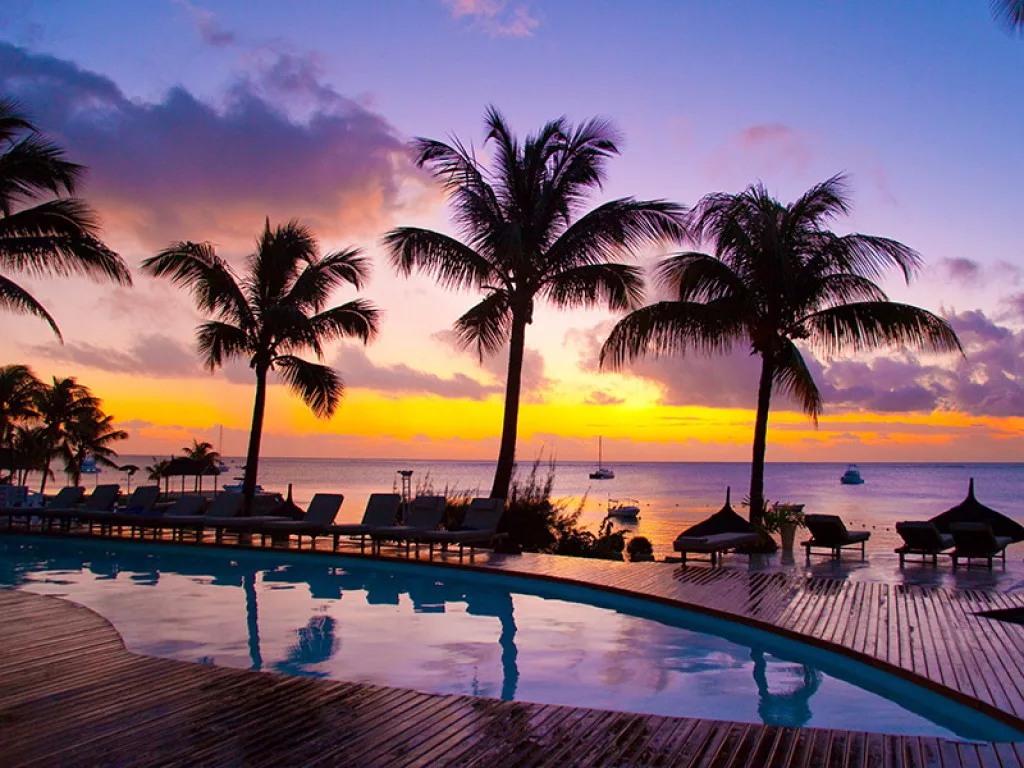
OUTLOOK RECOMMENDS
Sleep:
FOR LIVIN’ LIKE A LOCAL…
Attitude Hotels offers a beautiful selection of 3.5-star and 4-star hotels across the island. Whether adults-only, like Lagoon Attitude, or a family-friendly choice such as The Ravenala Attitude, all Attitude properties are united by the Group’s visionary ethos of living like a local. Authentically incorporating Mauritian culture, each hotel offers a host of local experiences and equips you with the Otentik Discovery app to explore hidden gems. The interior design across the hotels showcases traditional Mauritian decoration, while offering cuisine that celebrates the island’s culinary traditions and supports local farmers. Enjoy the gentle pace of life in harmony with your natural surroundings.
FOR A 5-STAR STAY IN SECLUDED TURTLE COVE…
Le Jadis Beach Resort & Wellness Mauritius
FOR A FAMILY-FRIENDLY GETAWAY ON LE MORNE PENINSULA…
JW Marriott Mauritius is a luxury resort offering an endless array of recreational activities on one of the island’s most iconic beaches against the stunning backdrop of Le Morne Brabant Mountain. Expect a host of supremely comfortable suites, finished with colonial-style décor that exudes a timeless luxury.
FOR SAVOURING THE ISLAND LIFESTYLE IN A PARADISICAL SETTING…
Occupying an idyllic position in the quiet fishing village of Grand Gaube, the Veranda Paul et Virginie Hotel & Spa promises to immerse you in the islander lifestyle. As an adults-only retreat with a ‘couples concept’, this romantic spot delivers an intimate cocoon to unwind and indulge in the beauty of the lagoon. Guests will never tire of the scenery of the crystal clear sea setting and breath-taking views across to the northern islands from a selection of indulgent ocean-facing rooms. Elsewhere, experience an enchanting culinary journey at the Veranda Resort’s primary restaurant, Isle de France, where expert chefs promise to captivate you with the flavours of Mauritian cuisine.
Beyond the resort, Veranda provides a host of activities to keep you entertained. Explore the island with a scenic bike ride, play a gentle game of pétanque or take a boat trip across the lagoon, setting sail in a traditional pirogue or taking a catamaran ride to Bernaches Islet. Those seeking to experience pure wellness should make use of the on-site Seven Colours Spa, where traditional oriental techniques combined with local know-how and natural essential oils are sure to help you unwind in ultimate romance. At Veranda, there is no better place to watch the sun set into the Indian Ocean.
PORT LOUIS IN FOCUS
Found in the northwest of Mauritius, Port Louis is the island’s often-overlooked capital. Although typically excluded from itineraries in favour of more picturesque beach destinations, a day in Port Louis will expose you to a vibrant and dynamic place where modernity rubs shoulders with tradition – a microcosm of the country itself. Indeed, this teeming city embodies the many varying contrasts at play in Mauritius, in particular the colourful cultural collision that defines the island. This is evidenced across the city’s architectural footprint, with candy-coloured Hindu temples such as Kaylasson, and elegant sweeping Chinese pagodas such as the Tien Tan Chinese temple.
Traveller’s describe Port Louis as ‘the real’ Mauritius, showcasing an authentic flavour of local life. The bustling Caudan waterfront draws the majority of visitors to Port Louis, as an eclectic area showcasing some of the best places to shop, socialise, and seek nourishment. Although few choose to spend the night here – there are just two hotels – a street food tour through Port Louis is an essential addition to any visit to Mauritius.
No other location on the island so extensively covers the diverse flavours and tastes of the local gastronomical landscape. Here you will discover a host of restaurants and street food vendors. The city’s street food scene is world-renowned, and best experienced with a visit to the enormous Central Market (Bazaar) where you will find Indian, West and North African, Creole and European cuisine. Some staples include the sweet drink of alouda – a local favourite – and the traditional afternoon snack of confi, best sampled from Chinatown (Port Louis).
For insight into Mauritius’ colonial history, pay a visit to The Blue Penny Museum and see the Champ de Mars racing track built by the French in the 19th century. Be sure not to miss Port Louis for authentic insight into island life beyond the resorts.
Found in the northwest of Mauritius, Port Louis is the island’s often-overlooked capital. Although typically excluded from itineraries in favour of more picturesque beach destinations, a day in Port Louis will expose you to a vibrant and dynamic place where modernity rubs shoulders with tradition – a microcosm of the country itself. Indeed, this teeming city embodies the many varying contrasts at play in Mauritius, in particular the colourful cultural collision that defines the island. This is evidenced across the city’s architectural footprint, with candy-coloured Hindu temples such as Kaylasson, and elegant sweeping Chinese pagodas such as the Tien Tan Chinese temple.
Traveller’s describe Port Louis as ‘the real’ Mauritius, showcasing an authentic flavour of local life. The bustling Caudan waterfront draws the majority of visitors to Port Louis, as an eclectic area showcasing some of the best places to shop, socialise, and seek nourishment. Although few choose to spend the night here – there are just two hotels – a street food tour through Port Louis is an essential addition to any visit to Mauritius.
No other location on the island so extensively covers the diverse flavours and tastes of the local gastronomical landscape. Here you will discover a host of restaurants and street food vendors. The city’s street food scene is world-renowned, and best experienced with a visit to the enormous Central Market (Bazaar) where you will find Indian, West and North African, Creole and European cuisine. Some staples include the sweet drink of alouda – a local favourite – and the traditional afternoon snack of confi, best sampled from Chinatown (Port Louis).
For insight into Mauritius’ colonial history, pay a visit to The Blue Penny Museum and see the Champ de Mars racing track built by the French in the 19th century. Be sure not to miss Port Louis for authentic insight into island life beyond the resorts.
LANDMARK ATTRACTIONS
Le Morne
Located on a peninsula at the island’s south-western tip, this is the signature postcard image of Mauritius. The soaring mountain of Le Morne Brabant hosts popular hiking trails, while the beach below is blessed with serene turquoise waters, perfect for glass-bottomed boat tours, and the best kite-surfing in Mauritius. These idyllic shores were once a refuge for enslaved people during the heyday of the eastern slave trade route, when the island was an important stopover.
Île aux Aigrettes
This small coral islet off the south-eastern coast is a conservation and ecotourism project that will transport you back to an era before man set foot on the island – a time when you can still imagine the dodo thriving. Officially protected by the Mauritian Wildlife Foundation (MWF), here you can sight pink pigeons, giant Aldabra tortoises, and a treasure trove of endemic flora and fauna.
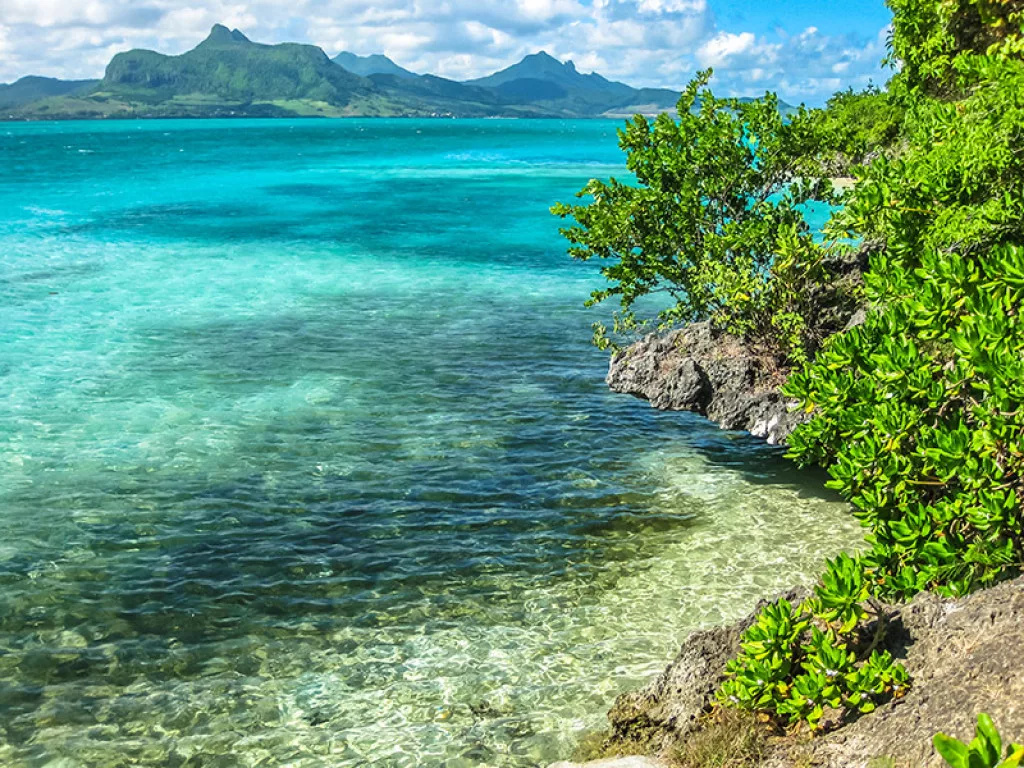
Eureka
Visit here for a transporting encounter into the island’s rich colonial history. Situated within a lush plantation estate, Eureka is a perfectly preserved Creole mansion originally built in the 1830s. Visitors can tour the grounds and house as a masterpiece in tropical architecture, where shaded verandas and over 109 doors helped to keep it cool during punishing summers, and the original furniture imported by the French East India Company still sits in place.
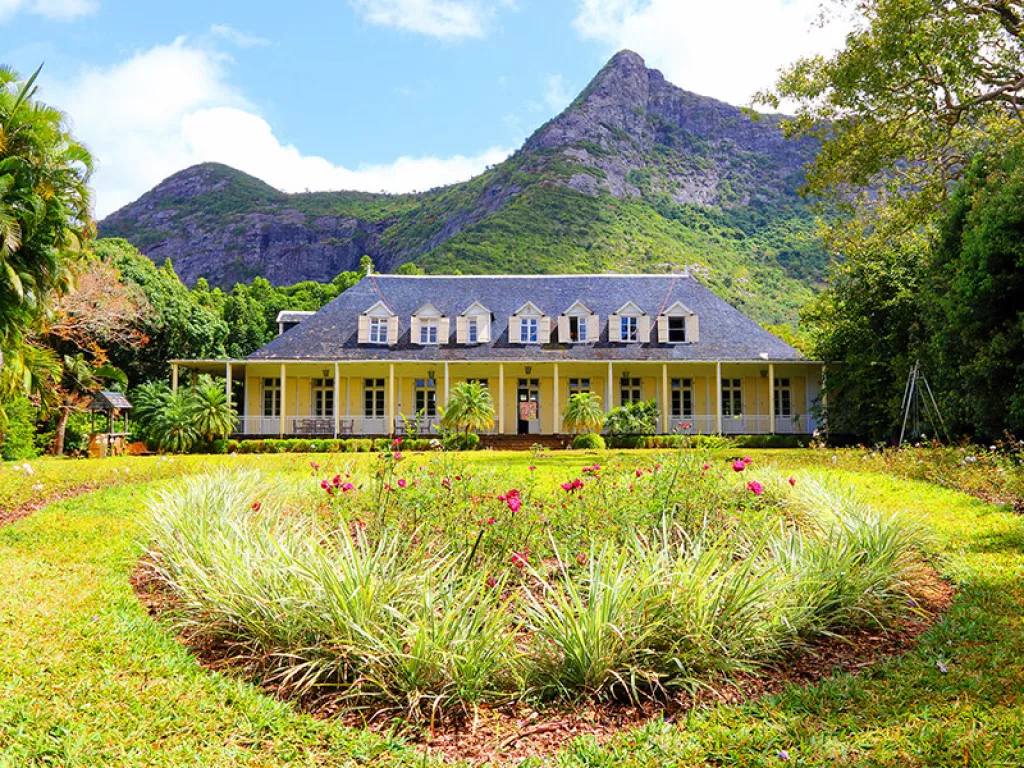
GETTING TO AND AROUND
The majority of travellers will arrive by plane at Sir Seewoosagur Ramgoolam (SSR) International Airport, located in the island’s southeast. From here, you can also take daily flights across to the sister island of Rodrigues through Air Mauritius.
If you are keen on exploring the island, rather than just commuting between the airport and the resort, there are several different means of transport available. Typically, the most popular option for tourists is to arrange minibus excursions run by reputable tour companies which can be booked through your resort or hotel. These are generally offered as part of a group itinerary, but can also be arranged on a private, bespoke basis.
For those seeking greater independence, self-driving across Mauritius is becoming increasingly popular. Many Western tourists favour this option, since the majority of road signs are in English and you drive on the left hand side of the road. However, be aware that road travel can be slow. Don’t let the island’s compact size fool you – although just 45 by 65 kilometres, two hour drives from hotels to attractions can be expected. There are two major highways connecting the island, but beyond this, roads are winding, narrow and often without pavements.
Elsewhere, public bus routes are a cost-effective means of exploring Mauritius, but be sure to choose the express rather than standard buses, since these are equipped with air-conditioning and offer a much faster service. The main bus transport hubs are located in Port Louis, Curepipe, Quatre Bornes, Flacq and Mahébourg.
Finally, bike hire is not generally advised in Mauritius due to erratic traffic. However in quieter coastal locations, this can be a fantastic way to explore. This especially applies to the quieter south and east coasts, and Le Morne Peninsula, where bike rental is available from hotels and tour agencies to discover a cyclist’s paradise that is almost entirely free of traffic.


